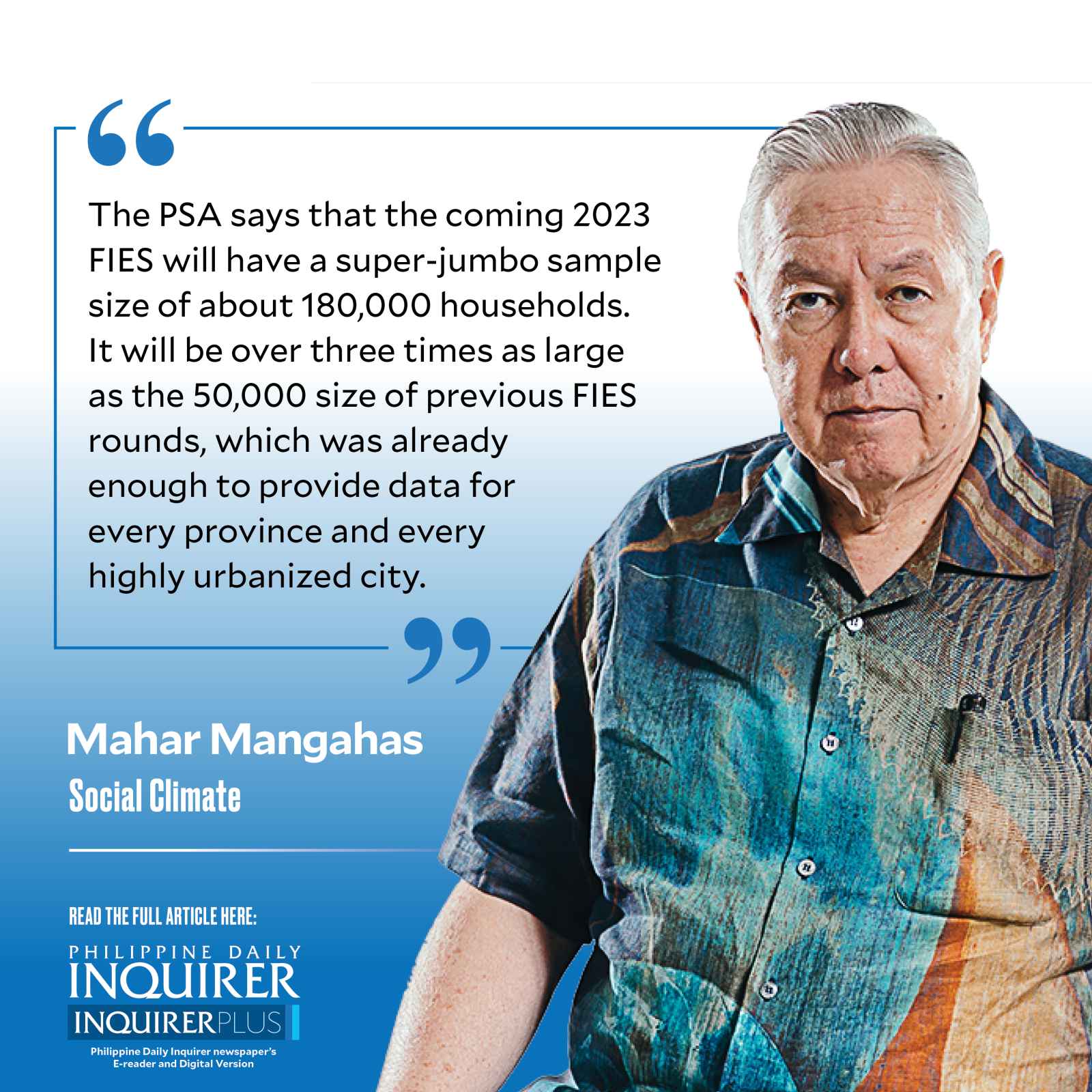Faster income surveying

The most important news on the statistics front is the upgrading of the government’s family income surveying to every two years instead of every three. The Philippine Statistics Authority (PSA) recently announced a budget of P590 million to do its next survey for reference year 2023 (“PSA clears the conduct of the 2023 Family Income and Expenditure Survey (FIES),” psa.gov.ph, 6/5/23).
This implies only a two-year gap from the last FIES of 2021 and suggests that the succeeding rounds will be for reference years 2025, 2027, and so on. The previous FIES rounds on the triennial schedule were for 2021, 2018, 2015, and so forth, going back to 1985, for a measly total of 13 rounds in a span of 36 years.
With the new schedule, the government will shut its eyes to poverty only every other year, instead of two years out of three (“Periodically blind on poverty,” 3/4/23). This is a big improvement.
Of course, it can’t compare, in the apples-to-apples sense, to Social Weather Stations’ quarterly monitoring of Self-Rated Poverty, which has produced a series of 139 observations since 1983, without surveying family income (see “40 years of poverty surveying,” 1/7/23, and “Social Weather Report: Filipino families Self-Rated as Poor steady at 51% since December 2022,” sws.org.ph, 5/7/23).
A typical FIES involves a lengthy questionnaire, to be implemented in two rounds. It seeks data for a whole calendar year, but assumes realistically that the interviewees can only remember what happened in the past six months; hence it requires two visits to a family being interviewed. Each visit takes some four hours of interview time, to get intense details about each family member’s income, each type of income, and each type of expenditure.
Shortening the interview by asking fewer and less detailed questions is hazardous. The government tried it before and found the disclosures much smaller than expected. The unexpectedly small income reported implied an embarrassing rise in poverty incidence, rather than the fall expected on the basis of gross national product figures from production surveys.
The lesson is clear: Never change the survey instrument when the purpose is to monitor what is happening to what you are surveying over time. Once you change the instrument, you in effect start a new series of survey numbers.
The first FIES visit will be this month, July 2023. If it follows previous practice, it will ask about the family’s income and expenditure in the first half of 2023; the results are expected to be released in December. The second visit, set for January 2024, will ask the same family for data pertaining to the second half of 2023; its results are expected in August 2024.
Then, before the end of 2024, the PSA should be able to consolidate the data from the two visits to come up with a report for the full year 2023. In like manner, there should be reports for reference years 2025 and 2027 by the close of years 2026 and 2028 respectively—a total of three reports during the current administration, instead of only two reports under the triennial calendar.
An FIES is highly focused on geographical details. The PSA says that the coming 2023 FIES will have a super-jumbo sample size of about 180,000 households. It will be over three times as large as the 50,000 size of previous FIES rounds, which was already enough to provide data for every province and every highly urbanized city.
I wonder how much finer will be the spatial details of the 2023 FIES—is it seeking data for each and every congressional district perhaps? Or data for each and every party list constituency? I’ve always thought that the PSA was sacrificing the monitoring of income over time for the sake of doing it over space. But if there are now enough funds for the fieldwork of three standard-size FIES, I think a yearly FIES is affordable.
The FIES series is a direct means of tracking economic inequality. We are told that the administration aims to convert the country into a “middle-class” economy. Pursuing this scientifically entails defining the economic classes.
Definitions can come from above. For instance, research at the Philippine Institute for Development Studies (PIDS) has suggested seven classes: 1. poor; 2. lower class; 3. lower-middle class; 4. middle-middle class; 5. upper-middle class; 6. upper class; and 7. rich. By “middle-class,” does the administration mean class 4 alone, or classes 3, 4, and 5 together? Does it adopt the PIDS class boundaries?
Whatever “middle class” means, governance will be smoother if how the government uses it does not clash with how the people understand it (“Counting the social classes,” 9/10/22 and “Social classes seen from below,” 9/17/22).
—————-
Contact: mahar.mangahas@sws.org.ph.
















